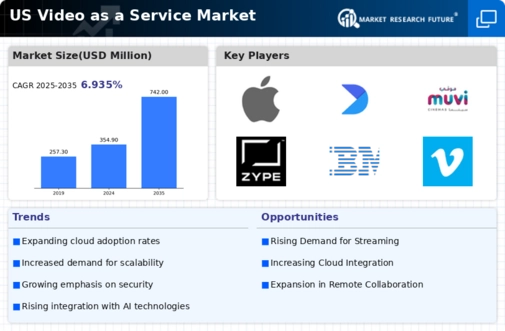Increased Focus on Cost Efficiency
Cost efficiency is becoming a critical driver in the video as-a-service market. Organizations are increasingly seeking solutions that provide high-quality video services at lower operational costs. The shift from traditional video infrastructure to subscription-based models allows businesses to reduce capital expenditures while maintaining access to advanced video capabilities. Recent studies suggest that companies can save up to 30% on video-related costs by adopting video as-a-service solutions. This financial incentive is particularly appealing to small and medium-sized enterprises, which may lack the resources for extensive video infrastructure. As more organizations recognize the potential for cost savings, the video as-a-service market is expected to grow, driven by the demand for affordable and efficient video solutions.
Emergence of Mobile Video Consumption
The emergence of mobile video consumption is reshaping the landscape of the video as-a-service market. With the proliferation of smartphones and tablets, consumers are increasingly accessing video content on-the-go. This trend is supported by data indicating that mobile video consumption accounts for over 70% of total online video views in the US. As a result, service providers are adapting their offerings to cater to mobile users, ensuring that content is optimized for various devices and network conditions. This shift not only enhances user experience but also expands the potential audience for video services. Consequently, the video as-a-service market is likely to experience growth as providers focus on delivering mobile-friendly solutions that meet the demands of a mobile-centric audience.
Growing Adoption of Cloud Technologies
The increasing adoption of cloud technologies is a pivotal driver for the video as-a-service market. Organizations are migrating to cloud-based solutions to enhance scalability and flexibility. This shift allows businesses to access high-quality video services without the need for extensive on-premises infrastructure. According to recent data, the cloud services market in the US is projected to reach $500 billion by 2025, indicating a robust growth trajectory. As companies seek to optimize their operations, the video as-a-service market benefits from this trend, as cloud solutions facilitate seamless video streaming and storage. Furthermore, the ability to integrate with existing cloud applications enhances the appeal of video services, making them more attractive to a diverse range of industries. This trend suggests that the video as-a-service market will continue to expand as more organizations embrace cloud technologies.
Rising Consumer Expectations for Quality Content
Consumer expectations for high-quality video content are rising, significantly impacting the video as-a-service market. Viewers now demand seamless streaming experiences, high-definition visuals, and interactive features. This shift in consumer behavior compels service providers to invest in advanced technologies to meet these expectations. Data indicates that 80% of consumers are more likely to abandon a video if it buffers or lags, underscoring the importance of quality in retaining viewers. As a result, companies in the video as-a-service market are focusing on enhancing their offerings to deliver superior content. This trend not only drives competition among service providers but also encourages innovation in content delivery methods. Consequently, the video as-a-service market is likely to witness sustained growth as providers strive to meet the evolving demands of consumers.
Integration of Artificial Intelligence Technologies
The integration of artificial intelligence (AI) technologies is emerging as a transformative driver in the video as-a-service market. AI applications, such as automated content tagging, personalized recommendations, and enhanced video analytics, are becoming increasingly prevalent. These technologies enable service providers to offer tailored experiences to users, thereby improving engagement and retention rates. Recent reports suggest that AI-driven video solutions can increase viewer engagement by up to 50%. As organizations seek to leverage data for better decision-making, the incorporation of AI into video services is likely to enhance operational efficiency and content delivery. This trend indicates that the video as-a-service market will continue to evolve, driven by the demand for innovative and intelligent video solutions.





















Leave a Comment